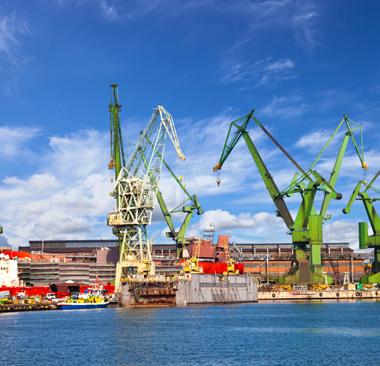
4 minute read
PORT CITIES SEA OF ATTRACTIONS
from MAEM MAGAZINE 8
by MAEM
Are you heading to a port about which you know nothing? We will try to help you.As the old saying goes, 'It is not just work that makes you live'. How can you make the most of your free time when you are in port? Each of them is different, has its own specificities and climate. They have one thing in common - each one is beautiful in his own way and is worth spending some time on. Especially, when you have a lot of time, waiting for unloading or going out to sea.
We are starting a new series of articles in which we will tell you how to spend
time in Europe's most famous port cities. We start with the Tri-City - the ports closest to MAEM headquarters in Krakow. The Tri-City - Gdansk, Gdynia and Sopot - are still three separate cities, but as they developed, the borders naturally began to blur and as a result, one of the largest Polish agglomerations was created, with about 750,000 inhabitants. Each of the cities that make up it has its own specificity, each one deserves to be known more closely. We will focus on the most important information, and it will take a maximum of two days to see the attractions we will tell you about.
Gdynia, Port
Gdynia is the youngest part of the TriCity. Originally, it was a fishing village, later a holiday resort, which was granted city rights in 1926. It owes its dynamic development to the sea port. The decision to establish it was due to the hostile attitude of the authorities of the Free City of Gdansk to Poland. Construction began in 1921, and in 1923 the port of Gdynia accepted the first ship under a foreign flag - SS ‘Kentucky’. Further history of the city and the port is its dynamic development - in 1930 the first regular passenger line GdyniaNew York was launched. In 1934, Gdynia became the largest port on the Baltic Sea in terms of volume of transhipments, and at the same time the most modern in Europe. As a result of World War II, the port was largely destroyed, but the city itself managed to avoid significant losses. The post-war years were marked by further development of the city and the port. Today, Gdynia is a modern maritime centre, one of the fastest growing Baltic ports.
Sopot, Molo

Sopot is a popular holiday resort, located between Gdynia and Gdansk. Beautiful, wide, sandy beaches and rich nightlife attract crowds of tourists all year round. The best known symbol of Sopot is the longest pier in the Baltic Sea. It is about half a kilometer long - the walking part is 511.5 m long, of which 458 m enters the Gulf of Gdansk. In the head of the pier is located the ‘Pier’ seaport in Sopot. A characteristic place on the map of Gdynia is the representative Kosciuszko Square Luxury hotels, restaurants and bars, the Music Theatre, beautiful modernist tenement houses and the Polish Navy Command building are located nearby. The Sea Towers skyscraper built in 2003-2006 dominates the area. There are also numerous monuments on Kosciuszko Square itself, e.g. the Sea Towers: The Polish Sailor 1939-1945, the Polish Armed Forces in the West and Home Army Soldiers, as well as the Polish Maritime Monument unveiled in 2018. The South Pier is an extension of Kościuszko Square. The ORP ‘Blyskawica’, the oldest surviving destroyer taking part in World War II, currently transformed into a museum, and a training sailing ship - the ‘Dar Pomorza’ museum - are docked there.

Gdansk is the largest and the oldest of the three centres making up the Tri-City. It boasts a rich history. The first records date back to 980, when the missionary Wojciech came to the pagan lands. Over the centuries the city has passed from hand to hand several times under the rule of Poland, Prussia or Germany. It was here that the key events of the 20th century, crucial for Poland and Europe, took place. One of the first shots of World War II fell on Westerplatte when the battleship ‘Schlezwig-Holstein’ attacked the Polish coast.


Gdansk, Shipyard
In the course of its operations, the Gdansk Shipyard has built over 1,000 fully equipped seagoing vessels, including container ships, passenger ships and sailing ships. The Gdansk shipyard is home to the NSZZ ‘Solidarność’, Europe's largest workers' movement, which initiated talks with Polish communist government. The August 1980 agreements were signed at the shipyard and, later on, the NSZZS Solidarnosc had a huge impact on the overthrow of the communist system in Poland.
Gdańsk, The crane
Today, Gdansk is a modern metropolis, inextricably linked to the sea and the maritime industry. The city has a beautiful and rich old town, whose element is also probably the most recognizable local monument - the crane on the Long Embankment.

We hope that the article will encourage you to get to know the Tri-City Metropolis more closely and spend here nice moments before your further journey. In the next article, which will tell you about the curiosities of the main European port cities, we will stay in Poland. This time, however, we will move to its western coast, to Szczecin.









